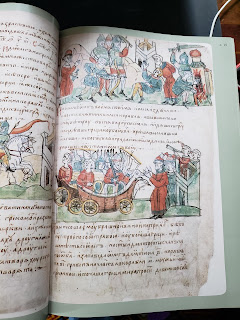Christmas came early this year! I recently found for sale a facsimile of the Radziwiłł Chronicle. The book was located in Russia, and I thought shipping would take a few more weeks, so I was surprised to find that it had already arrived.
The Radziwiłł Chronicle is a 15th century copy of a 13th century manuscript. It is a copy of the Primary Russian Chronicle (Повесть временных лет) famous for its 600+ miniatures illustrating the history of Kievan Rus’ up until 1206. The book belonged to Princes Radziwiłł of Lithuania (later part of Poland) in the 17th and 18th centuries, but now resides at the Russian Academy of Sciences in St. Petersburg.
The copy I purchased has two tomes. The first is a facsimile of every page cover to cover of the original; the second contains scholarly articles, a transcription of the medieval Russian text, and description of each of the minatures.
 |
| The covers of the two books. Each tome is pretty hefty. |
 |
| A sample of the descriptions of the minatures. |
 |
| A sample of the text transcript. |
I’ve seen a handful of the miniatures online, but it’s nice now to have the complete set. Stylistically, they remind me of the Bayeux Tapestry. I think they’d make a great embroidery project.
 |
| The Apostle Andrew foretells the foundation of Kiev. According to Eusebius, while he was visiting the Greek colonies around the Black Sea, he traveled north into the Slavic lands, possibly as far as Novgorod, and while on the Dneipr River, prophesied the foundation of a great city. This story was popular with the Slavs in the 10th and 11th centuries as evidence that Kievan Rus’ was preordained to accept the Orthodox faith. |
 |
| According to the Russian Chronicle, in 907, the Rus’ prince Oleg made war on the Byzantines, sailing a large army of troops to Constantinople. The Greeks chained the Bosphorus to ward off the Russians’ boats, so they attached wheels to the boats and sailed them overland to attack the city, and the Greeks sued for peace. Strangely, the Byzantine chronicles make no mention of this ignominious defeat. |
 |
| Many of the stories in the Primary Russian Chronicle focus on their wars against various groups, including the Derevlians / Pechenegs, another Slavic tribe who were their constant enemy. |
 |
| Given their Viking ties, it’s not surprising the Rus’ used longboats to travel by river and to make war on their neighbors. |







